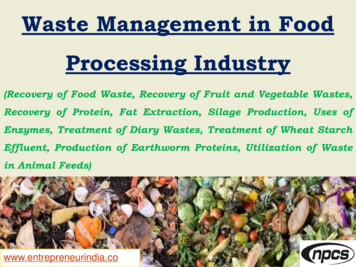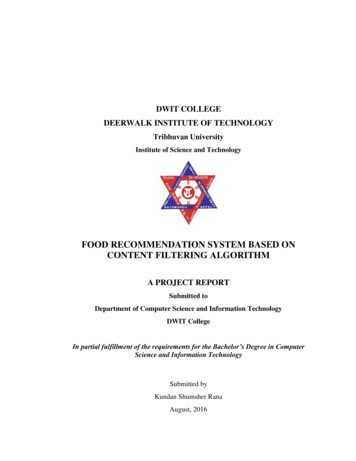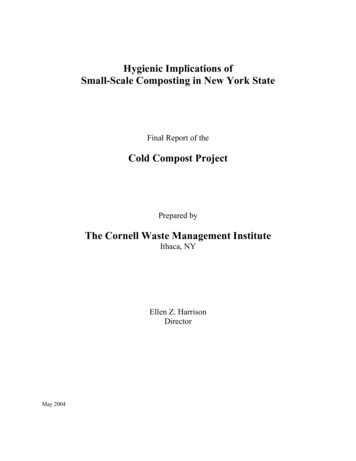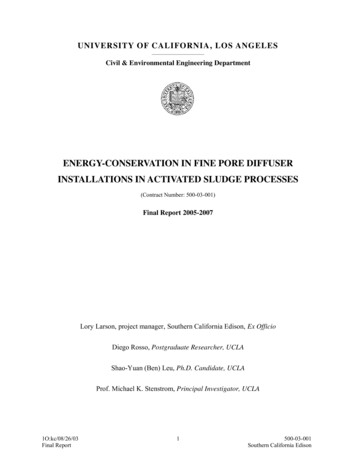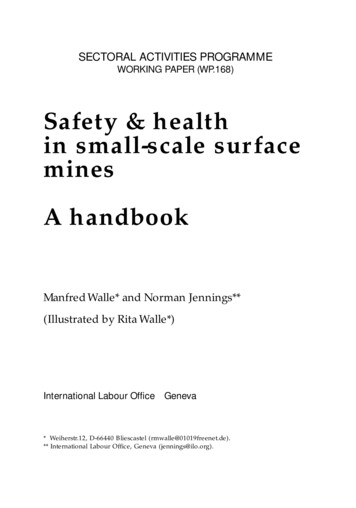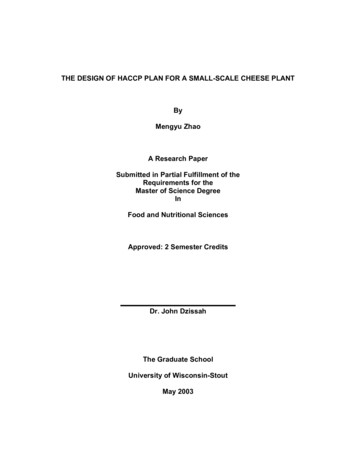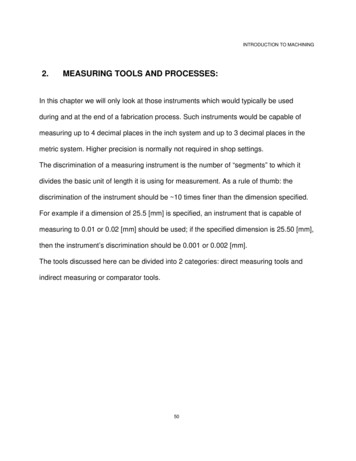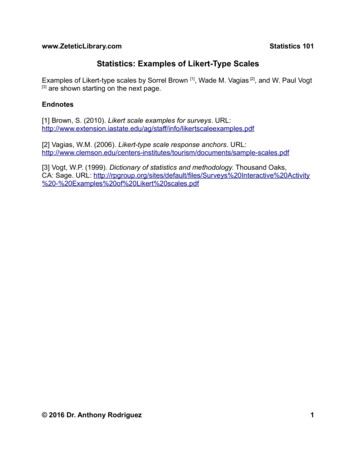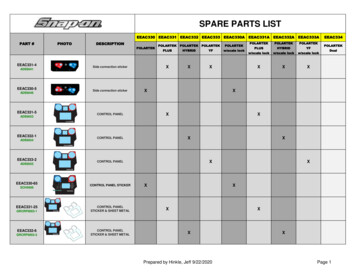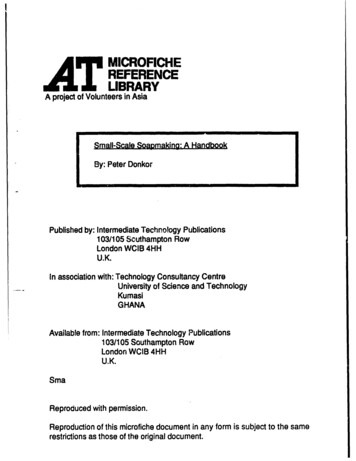
Transcription
MlCFlOFlCHEREFERENCELIBRARYA project of Volunteers in AsiaSmall-S&SoapmakimHandbookBy: Peter DonkorPublished by: Intermediate TechnoFogyPublications103/l 05 Scuthampton RowLondon WCIB 4HHU.K.In association with: Technology Consultancy CentreUniversity of Science and TechnologyKumasiGHANAAvailable from: Intermediate Technology Publications103/l 05 Southampton RowLondon WCIB 4HHU.K.SmaReproduced with permission.Reproduction of this microfiche document in any form is subject to the samerestrictions as those of the original document.
SnKALL-SCALE SOAPMAKINGA handbookPeter DonkorTechnology Consultancy Centre, llniversity of Science andTechnology, Kumasi, Ghana in association with IT Publications1986
-Intermediate Technology Publications Ltd., 103-105 SouthamptonRow, London WClB 4HH, UK.@ TCC and Intermediate Technology Publications 1986.Reprinted 1989ISBN 0 946688 37 0Printed by the Russell Press Ltd., Bertrand Russell House,Gamble Street, Nottingham NG7 4ET, UK.
ContentsPagePREFACEACKNOWLEDGEMENTSCHAPTER 1: INTRODUCTION1.11.1.11 1.21.1.31.1.41.21.31.4Brief History of SoapmakingThe Development of Soapmakingin EuropeThe Development of Soapmakingin GhanaLqe-scale SoapProduction in GhanaThe Roie of ResearchInstitutions in GhanaDefinition and Properties of SoapHydrolysis of SoapDetergent ActionCHAPTER 2: RAW MATERIALSFOR 42.3Fats and OilsClassificationof Fats and OilsBrief Chemistry of Fats and OilsCommon Oils Used in Ghana for SoapmakingAlkalisCausticSodaDescription of Processfor Local ProductionCaustic PotashDescription of Processfor Local ProductionOther raw materialsVixxi111233445664710131314171819
CHAPTER 3: THE CHOICE OF SUITABLEOILS AND FATS FOR SOAPMAKING3.13.23.33.3.13.4Saponification ValueIodine NumberINS FactorPrtictical Application of INS FactorLathering and Solubility Properties of SoapCHAPTER 4: PLANT AND EQUIPMENT FORSOAPMAKING4.14.1.14.1.24.1.34.1.44. f .54.24.2.14.2.24.2.34.3Equipment and Plant for Laundry SoapmakingSoapBoiling TanksCausticSodaStorageTanksSoapMoulding BoxesSoapCutting TablesSoapStamping MachinesEquipment and Plant for Toilet SoapmakingMixing MachinesMilling MachinesPloddersOther Equipment and ToolsCHAPTER 5: PRE-TREATMENTOILS FOR SOAPMaKING5.151.15.1.25.1.3Refining of Oils and FatsAlkali RefiningAnother Clarification MethodBleaching of Oils and FatsSemi-boiling ProcessProcessingmethodFull-boiling ProcessSaponification ProcessGraining OutClear Boiling and FittingTreatment of Settled SoapsLiquoringFillingFramingDrying and StampingCold Processvi272727292929313131323334OF FATS ANDCHAPTER 6: THE PROCESS OF 46464747, 49
CHAPTER 7: SMALL-SCALEOF TOILET SOAPCold IONMilled Toilet SoapmakingDrying of SoapBaseMixing of Perfume and DyeMillingCompressingCutting and StampingRemelted SoapsCHAPTER 8: NON-EDIBLE OILS FORSOAPMAKING8.18.1-l8.28.2.18.38.3. f8.4Neem OilSoapmakingpropertiesCastor esProcessof SoapmakingCHAPTER 9: GHANA STANDARDSSPECIFICATIONS FOR SOAPS9.19.29.39.49.59.6Filled Hard SoapSpecificationsGenuine Hard SoapSpecificationsFilled Carbolic SoapSpecificationsToilet SoapSpecificationsMedicated SoapSpecificationsPackagingand Marking of SoapsAPPENDIX 1: Sometypical formulations for soapsAPPENDIX 2: Properties of soapsfrom different 64644465456770
PrefaceIn April and May 1985, I visited Ghana to gather data for abook on the work of the Technology Consultancy Centre atKumasi’s University of Science and Technology. TCC wasfounded in 1972, in an effort to adapt and transfer to ordinaryGhanaians some of the knowledge that is often held captivewithin university walls. It was soon discovered, however, thatthe development of appropriate technologies was not the samething as the transfer of technology, and it becameclear that theCentre would have to involve itself not only in projects thatwere relevant to the cultural and economic environment of thecommunity, it would have to become involved in thecommunity itself. This, in turn, led to an appreciation thateven a basic technology like soapmaking cannot becompartmentalized. Thus, making soap became a bit likepulling a thread on a shirt: if you pull long enough, you willfind that it is connected to half the universe.Making soap in the context of Ghana’s protracted economicdifficulties meant not only the development of a simple methodthat could meet rural conditions, but one that could survive thetemperament of the wildly fluctuating market place as well.When caustic soda, an essential ingredient, becameunavailable, TCC devized a technique and equipment for localmanufacture. The traditional method of extracting oil from thepalm fruit is laborious and expensive,and so in order to reducecosts and the burden on the women who do the work, TCCdeveloped a low-cost oil press, the production of which is nowfirmly establishedin severalsmall workshops in Kumasi. Whenix
,palm oil became aimost totally unavailable during the droughtand the economic crisis of 1983, TCC began a search for nonedible oil substitutes, conducting successfulexperiments withboth neem and castor oil. Perfume was developed from lemongrass. A measure rf the successof such experiments is therecent adoption of some of TCC’s techniques and findings bythe large iever Brothers soap plant in Accra.Peter Donkor’s book modestly avoids discussionof the greatpains that he and others put into the development of thetechnology he describes, and of the successthat has beenachieved in having the processadopted on a widespread scalein Ghana, by small urban and rural entrepreneurs, by villageco-operatives and by development organizations. A furthermeasureof successhas been the number of requestsfrom othercountries in Africa for assistancein establishing the process.Peter Donkor has travelled to Guinea Bissau. Mali, Togo,Sierra Leone and Mozambique to help set up smallsoapmaking enterprises. We is therefore uniquely equipped towrite about a processwhich ha,sbeen tried and tested, not onlyin the sterile laboratories of the Ghana StandardsBoard, but inthe bustling shops and stalls of the Ghanaian market place.Ian SmillieLondon, 1986
AcknowledgementsThere is no doubt about the fact that a lot of people havecontributed in one way or another to the successof this book.My special thanks go to Dr. J.W. Powell, Director of TCC,whose encouragement and editing as well as contact with theIntermediate Technology Publications made the publication ofthis book possible. My sincere thanks also go to theIntermediate Technology Development Group in the UK,for funding the printing of the first edition of this book.I will also like to expressmy heartfelt thanks to the followingpeople and companies: Miss Esther Akom and her assistantsMiss Grace Dery and Angelina Pamford, all of TCC, whotyped the draft of this book, Mr. W.A. Osekre, the Universityphotographer who printed some of the pictures used in thebook, the Obegam Soap Enterprise, Kumasi, and KwamotechLtd, Kwamo, who allowed some pictures of their workshops tobe taken for this book.Last and not the least, my special gratitude goes to Mr.Smillie who agreed to write the preface of this book. Mr.Smillie paid a visit to TCC (when this book was being written)to write up a comprehensive report on the activities of theCentre.NoteFurther information about equipment such as that mentionedin Chapter 4 can be obtained by writing to the TechnologyConsuitancy Centre, Kumasi, Ghana.xi
Chapter 1Introduction1.1 Brief History of SoapmakingThe need for soap, a cleansing agent, has been felt ever sinceman became aware of the necessity to clean his body andenvironment in the primitive ages.Soap has therefore acquiredthe status of a basic necessity in the modern civilized world.Soapmaking is one of the oldest industries in the world; mostauthorities claim that it originated on the sacrificial altars ofearly primitive people, when fat from animals killed on altarsdripped over wood ashes, thereby combining with the potashin the ashesto form crude soap.1.1.1 The Developmentof Soapmalcingin EuropeIt is recorded that the Gauls were the first to produce soap bymixing goat fat (tallow) with potash from beechwood ashes,and were followed by the Romans who learnt the art after theconquestof the Gauls, under Julius Caesar. Soap manufactureseemedto flourish in the eighth century in Spain and Italy, andwas introduced in France some 500 years later, when factorieswere establishedin Marseilles for soap manufacture from oliveoil. In the fourteenth and fifteenth centuries, soap wasmanufactured on a commercial scale in Italy in the city ofSavona, and the words “savon”, “sabon” and “jabon”, whichare French, Portuguese and Spanish words respectively forsoap, are derived from the name of the city.The first record of soapmaking in England is in 1552, andfrom this time to the beginning of the 19th century,manufacture of soap developed very slowly, being carried onessentiallyby the rule-of-thumb method. In 1787and the yearsthat followed, a major breakthrough was made in soap
production as a result of two discoveries. Nicholas Leblancdiscovered a process for the chemical production of causticsoda from common salt in 1787,and a few years later MichaelEugene Chevreul carried out a successful research into theconstitution of fats and oils, and demonstrated thatsoapmaking was a chemical process involving the initialsplitting of fatty acids and glycerol. These findings gave thesoapmaker an unlimited supply of one of his basic rawmaterials - caustic soda. They also placed the soap industryon a scientific basis as soapmakerswere now in a position toknow the nature of the chemical reaction involved insoapmaking.The history of many modern soapmaking companies inEngland can be traced back to the eighteenth and nineteenthcenturies, although their growth at the time was hampered byhigh taxation. However, following the scientific breakthrough,soap taxation was abolished in England, resulting in the rise ofthe demand and supply for soap. During this period, W .G.Lever became a dominating figure in the soap trade inEngland. In 1884, he introduced sunlight soap for the firsttime. Gradually, other soap manufacturers began developingdifferent kinds of soap for cleaning different articles, and moreattention was also given to the form in which the soap waspresented. Lux flakes, for example, were first marketed in1900,and were a big success.Lever also introduced the use oftropical vegetable fats and oils like palm oil, coconut oil, palmkernel oil, etc, for the making of soap at a time when thetraditional sourcesof animal fats for soapmaking were runningbehind demand in England.1.12 The Developmentaf Ssapmakingin GhanaSoapmakingwas an indigenous technology in the country longbefore the arrival of the Portuguesein 1482,especially amongthe Fanti tribe who were making soap from crude palm oil andpotash from wood ashes.Though this potash soap is still beingmade and used in the rural areas of Ghana, very littleimprovement has been made on the processing method toproduce a good quality soap acceptable to the urban soapconsumers.Probably the rural population still enjoys the useofthis soap for bathing purposes because of its good cosmeticproperties. Though the soap is very soft and usually black or2
ash colour, it is very mild and has some bleaching property onthe skin, which has made the use of the soap very popularamongwomen who prefer to be fair in complexion. Apart fromits bleaching property, it is also used for dermatologicalpurposes. Its use in the treatment for ringworm, and prickleheat rashesis well known.The sort of nature of potash soap, and its short-shelf lifecoupled with the difficulty in the preparation of caustic potash(prepared from the ashesof cocoa pods, plaintain peels, etcjand/or the scarcity of potash at the local market, has limitedthe production of this soap to some extent. It was no surprisethat when the country was colonized the indigenoussoapmakersswiftly switched over from the production of thetraditional soap to the laundry soap introduced by the colonialmasters, which involved the use of ready-made importedcaustic soda.1.1.3 Large-scaleSoap Productionin GhanaSince the first Portuguese stepped on the shores of the land,laundry soapmaking has steadily been carried out on a smallscaleby local soapmakersalong with the dwindling volume ofpotassium soap production. In 1963, Lever Brothers set up asoap complex in Tema to start large-scale production oflaundry, toilet and powder soapsto boost the local productionof soap. More recently, two other soap complexes have beenestablishedin Kumasi and Cape Coast.l.I.4The Role of Research Institutionsin GhanaOne interesting situation with the local prc,duction of soap inthe country is that very little attempt has been made toimprove on the quality of soap produced. It is unfortunate thatup till n#Jwall sorts of low quality soaps popularly known as‘Don’t touch me’, becauseof their high caustic soda contentand slippery nature, are produced in the country.Although some researchprogrammeshave been carried outto improve the quality of soap by the research institutions,their findings have not benefited the small-scale traditionalsoapmakerswho produce both the laundry and potash soaps.The biggest attempt yet made was by the TechnologyConsultancy Centre (TCC) which in 1983set up a pilot soapplant to conduct researchon the improvement of local soaps3
and to offer free training to local soapmakers on thetechnology of good quality soap production. The Centre stilloffers this training and produces soapmaking equipment forsale to local soapmakers.The Centre’s current soap training programme is gearedtowards the production of laundry soap but some attempts arealso being made to improve the colour and hardness of thetraditional potash soap.1.2 Definitionof PropertiesThe definition of soap is generally restricted to thecombination of fatty acids and alkalis obtained by reactingvarious animal and vegetable fats and oils with caustic soda orpotash, the former giving hard soap and the latter soft soap.Both soaps are readily soluble in hot water or alcohol.However, they dissolve very slowly in cold water forming aturbid solution owing to slight decomposition. Sodium soaps(made from caustic soda) are found to be insoluble in verystrong caustic solutions, and for the most part in strongsolutions of brine; hence the addition of strong solutions ofbrine to a solution of sodium soap causesthe soap to separateout and rise to the surface of the caustic or salt so!ution. Thisseparation (also referred to as ‘graining’) of soapis employed incommercial soap production. On the other hand, addition ofbrine to a solution of potassium (potash) soap merely results indouble decomposition giving rise to sodium soap andpotassium chloride.Thus C17H3sCOOK NACl Cl7 HD5COONa KC1i.e. (Potassium Soap) (Common Salt) (Sodium Soap) (Potassium Chloride)The solubility of different soaps in brine varies veryconsiderably.1.3 Hydrolysis of SoapWhen soap is treated with cold water it is said to undergohydrolysis- the breaking down of the soap into its componentparts. The hydrolysis results in the liberation of an acid salt.The reaction can be represented in its simplest form by theequation:4
2 Cl7 Hs5 COONa -t Hz0 N&X-I HNa (C,7H35COO),(Soap) (Water) (Caustic Soda) (Acid Salt)1.4 Detergent ActionMany theories have been proposed to explain the detergentaction of soap - the property possessedby soap to removedirt. However, the commonest explanation is that the alkaliliberated in the processof hydrolysis attacks any greasy matteron the surface being cleam d, and as fat is dissolved, theparticles of dirt are loosened and easily washed off.Another theory suggests that the alkali set free by thehydrolysis of soap serves as a lubricant, making dirt lessadhesive, and thus promoting its removal.Yet another theory states that the alkali tends to lower thesurface tension of the water, and thus permits theemulsification of fat-bearing dirt particles on the surface of thematerial being cleansed.5
Chapter 2Raw Materials forSoapmakingThe raw materials for the making of soap cover a wide range ofsubstances which may be classified under the followingheadings:I. Fat and oils2. Alkalis3. Filling agents4. Water5. Salth. Perfumes7. Colours or dyesHowever. fats and oils constitute approximately 00% of thesoapmaker’s raw materials. and ;I dctaiicd treatment of fatsand oils is made in this chapter.2.1 Fats and OilsThe cost of production and properties of any particular soapare largely dependent on the nature and properties of thevarious oils and fats used in its manufacture. Thus it is veryimportant for the soapmakcr to be f’ulty conversant with thephysical, chemical and soapmaking propcrtics of t hc oils andfats being used. Since no two oils have identical soapmakingproperties, the art of soapmaking lies not only in the boilingoperation but in the judicious selection of the oils and fats toproduce the qualities needed.2. I .I. Classificationof Fats and OilsFats and oils are esters of fatty acids and glycerol.Thedistinction between fats and oils is purely an arbitrary one,based on their physical state at ordinary temperatures - the6
oils being liquid and the fats solid or pasty.Fats and oils are divided into three classes, namely, fixedoils, mineral oils and essential oils. However, fixed oils formthe main raw materials for soapmakingas they decomposeintofatty acids and glycerol when strongly heated, and are easilysaponified by alkali. Fixed oils and fats, which include bothanimal and vegetable fats and oils, are further classifiedaccording to their physical properties as follows:a) Nut oils: These oils are characterized by a largeproportion of fatty acids with low molecular weight, especialylauric acid. Examples of these oils are coconut oil and palmkernel oil. These oils (especially cuconut oil),when used intoilet soaps are the chief suds-producingingredients.They saponify easily with strong alkali solution (30-35”Be).Once these oils begin to saponify the processproceedsrapidlywith the evolution of heat. They also require large quantities ofstrong brine (1648”Be) to grain their soaps, and the grainedsoapstend to carry more salt than other soaps. These oils aremore suitable for the making of cold processsoaps.b) Hard Fats: The hard fats contain appreciable quantities ofpalmatic and stearic acids. Examples of these fats are palm oil,animal tallow and hydrogenated oils. These oils or fats produceslow-lathering soaps but the lather produced is more stableover long periods of time than the nut oils. In soapmaking,they are first saponified with weak alkali (10 lS”B@),and inthe final stageswith stronger alkali solutions.c) Soft Oils: These oils have substantial amounts ofunsaturated acids, namely olcic, linoleic and linoleneic acids.The soapmaking properties of these oils vary with their fattyacid composition, and the physical and chemical properties ofthe acids. Examples of these oils are groundnut, castor, cottonseed, fish oil and olive oil. These oils cannot produce hard soapwhen used alone for soapmaking. They arc usually blendedwith nut oils. Their soaps,however, lather freely and have verygood detergent properties.2.1.2 Brief Chemistryof Fats and OilsSoapmakinginvolves a definite chemical decomposition of fatsand oils into their constituent parts, namely fatty acids andglycerol. The fatty acids combine with caustic soda, potash orother base to form soap, and the glycerol remains free.7
Plate J: Oil pcilm tree8
All fats and oils used in soapmaking consist of a mixture ofcompoundsof glycerol with fatty acid which occur in nature inthe form of triglycerides.The most important of theseacidsfromthe soapmaker’spoint of view are stearin, palmitin, olein andlaurin. The presenceof stearin and palmitin, which are solidsat room temperature, gives firmness to fats and oils. Thegreater the percentagepresent the harder the oil or fat, and thehigher its melting point. Where olein, which is liquid atordinary temperature, is the chief constituent, the oil or fat issoft.The soapmaking properties of fats and oils can bedetermined by the molecular weights of their fatty acids. Withincreasing molecular weight in the caseof naturally occurringsaturated fatty acids in fat or oil, the following properties arefound:1. The boiling point of the oil rises,2. The melting point of the oil/fat rises,3. The saponification value of the oil/fat decreases.Also, the properties of their corresponding sodium soapsvary as follows with increasing molecular weight:1. The solubility increases,2. The lathering properties improve up to lauric acid anddeteriorate from lauric aoid upwards,Plate 2: Palm kernels
3.4.5.6.The stability of the lather increases,The detergent action decreases,The soapshave milder skin action as the series progresses,The property of holding filling solutions such as sodiumsilicate decreases.This explains the reason why nut oil (such as coconut oil)soaps lather readily and profusely but not stably. They alsohave a firm texture and are hard but dissolve more readily inwater than do soapsfrom the hard oils. They can also retain agood amount of water, and take up fairly !arge quantities offillers like sodium carbonate.Naturally occurring saturated fatty acids(The C,Hz,Oz Scrica)No. ofMeltingChefk.wlF0 rltllU Molix rrlarWeightPoint(“C)46810121416cg-i,COOHCSH 1,COOHCTH &OOHC,H ,&OOHC, ,H 228.37256.42-8- ArachidicBehcnicLignoccric202224C,pHa COOHG, eMy&ticPalmiticClJrboni-2.13 CommonOrcwsInMilk fatMilk fatMilk fatCoconutCoconutAnimal tGroundnutBccsw;lxOils used in Ghana for SoapmakingVarious oils and fats have become established in Ghana forscapmaking. These are all edible oils, although some attemptshave been carried out by the TCC to identify local non-edibleoils as substitutes for edible oils for soapmaking.These oils which are extracted locally using both commercialand traditional technologiesinclude palm oil, coconut oil. palmkernel oil, shea butter and cotton seed oil.1. Pc?lm OilPalm oil is extracted locally ::t” the commercial level using10
Phte3: Cocomittrw11
hydraulic presses, and at the small-scale level using handoperated screw presses.’ However, traditional extractiontechniques cater for about 30% of the total palm oil producedin the country. The oil forms about 5040% of the total oils andfats used in Ghana for soapmaking.Palm oil usually produces a crumbling soap which canot bereadily milled for toilet soap production, but with 20-25%coconut oil blend, it produces satisfactory toilet soap.ii. Coconut oilThe oil is produced from copra mostly in the Western Region,by the Esiama vegetableoil mill, using oil expellers. However,traditional extraction methods are used widely in the WesternRegion and other areas of southern Ghana. The oil isextensively used to blend other oils like shea butter, palm oiland cotton seed oil for soapmaking becauseof its property toproduce hard and lathering soaps. It also finds application inthe production of liquid soaps because its potassium soapremains clear at low temperatures.Because of its high saponification number, it requires astrong caustic solution (known as lye) for its saponification. Itssoap is usually white, firm and soluble with rapid forminglather which is not very stable.iii. Palm Kernel OilThis oil is produced mostly in Ghana using traditionaltechniquesand is usedinterchangeablywith coconut oil in both‘laundry and traditional potassium soapmaking. Its soap hassimilar properties to coconut oil soap.iv. Shea ButterShea butter is a fat which is extracted in the northern part ofGhana, where shea trees are found, using only traditionalextraction techniques. The fat is somewhat tough and sticky,and the amount of unsaponifiable matter present isconsiderable.The fat produces soap of soft consistency with oilyappearanceand thus needsto be blended with coconut or palmkernel oil to improve the hardnessand lathering properties. IiI. This technology was developed and promoted by the TCC. A full account o: !hetechnology can be found in the TCC report ‘The Dcvclopmentof Apprcp&!eTechnology hand screw press for the extraction of palm oil’ by Peter Donkor.12c
is the chief fat used in the north for soapmaking, since most ofthe other oils mentioned are not found in the north.v. Gutton Seed OilCotton seed oil is not widely produced in Ghana. The CrystalOil Company in Accra is the main producer of cotton seed oilsoap stock for soapmaking.The crude oil saponifieswith easebet the soap is difficult tograin. It produces soap of soft consistency, if used alone, andhas a bad odour.2.2 fiudisThe two alkalis popularly used in the making of soaps arecaustic soda and caustic potash.26.1 Caustic SodaCommercial caustic soda is creamy in appearanceand fibrousin structure. It readily absorbsmoisture and carbonic acid fromthe air to form sodium carbonate. Due to its hygroscopicproperty of absorbing moisture, it must not be exposedto theair. Caustic soda is also very corrosive to the skin andaluminium containers, and as such must be handled with greatcare. It is available on the market in various forms, namelyflakes, powder, sticks and blocks. The powder and the flakesare very convenient to handle but are costlier than the solid orblock caustic soda, and are normally used when the volume ofsoap production is very small. For large soap production units,however, it is more economical to buy solid caustic soda indrums. To remove the caustic from the drum, the drum is firstpounded on all sides with a heavy iron hammer, causing thecaustic soda to crack. The cracked caustic is then chiselled andbroken into pieces and dissolved in the right amount of waterto obtain the concentration needed.Gommercial PrvductionCommercially. caustic soda is pvlduced by the electrolysis ofbrine (sea water), the byproduct of such a process beingchlorine which is used for bleaching and water treatment. Thedescription of the processinvolved in caustic soda manufactureis beyond the scope of this book and will therefore not bediscussed.13
P1.A TE 3: Using hydrometer to &ermine the strength of caustic sodasohrtion.Lanrl Production (Using Precipito tiorr Rextim)In Ghana. the Technology ConsusltancyCentre (TCC) of theUniversity of Science and Technology (UST), Kumasi, hasdeveloped a technology for the local production of causticsoda. The technology which was designedto produce 1OOkgofcaustic soda of about 8Okgin 9-W% solution and 2Okgin 5%solution has generated a lot of interest amongst small-scalesoapmakers,and the government which is currently promotingthe technology among the membersof the Ghana Soapmakers’Association.2.2.2 Descriptionof process for local productionRaw mnteri&The raw materials required for the making of the caustic sodaare:a) sodium carbonate - an imported raw material bought from14
ICI (Ghana) Ltd., Tema, or the open market in 50kg bags;b) slaked lime - a by-product of the manufacture of acetylenefrom calcium carbide and water by L’Air Liquide.Presently, the lime is a waste material for the company, andis collected by soapmakersfree of charge.Eqru’pment:The equipment for the manufacture of the chemical is acylindrical tank reactor (Plate 5) made from galvanized steelsheet with a diameter and heigh; of 120cm(4ft). The reactor isequipped with four baffles which extend from top to bottom at90” to the walls of the tank. Their purpose is to promote agood agitation of the slaked lime suspension during thereaction. .Anagitator, axially positioned in the tank, consistsofa shaft and a 4-bladed axial flow turbine which is 1705cm(7in)above the bottom of the reactor. The width of each blade is4cm (Min), the length is 1605cm (&42in), and the pitch of theblade is 45”.The shaft of the agitator is directly rotated by a lhpelectric motor at a rotational speedof 950rpm. The agitator andthe baffles have been designed to keep the lime in suspensionduring the reaction.45cm (18in) from the bottom of the tank., along the walls ofthe reactor is a swivelling decanting pipe with 31.25mm (1Xin)valve through which the clear solution of caustic soda isdecanted, and at rhe centre of the bottom of the reactor is a1Ocm (4in) valve through which the sludge of calciumcarbonate (a byproduct of the reaction) and unreacted lime isdischargedafter rinsing with water.The reactor can be wood fired, or ellectrically heated withfive domestic heating elements each of 2kW rating. Thedesignedproduction capacity per day is 1OOkgof caustic soda,and has a design reaction temperature of 90 C and reactiontime of three hours.Pl-OCt?SSNine hundred litres of water is measuredinto the reactor andheated to a temperature of 92-95 C. Using the heatingelements, this temperature is attained after about eight hours’heating, but with strong firewood, it takes only about threehours. When the temperature is reached, the agitator is15
PLATE 5: Caustic soda plant.16
switched on, and 150kg of sodium carbonate introduced intothe water for absolute dissolution. When the carbonate iscompletely dissolved 182kg of dry slaked lime is introducedinto the reactor, and the reaction allowed to take place forthree hours to completion with continuous agitation. Afterthree hours, the heating is stopped and the calcium carbonatesuspension is then allowed to settle after which the clearsolution of caustic soda is decanted. The solution has a causticconcentration of 103g/litre and sodium carbonate
1.1.3 Lqe-scale Soap Production in Ghana 1.1.4 The Roie of Research Institutions in Ghana 1.2 Definition and Properties of Soap 1.3 Hydrolysis of Soap . kernel oil, etc, for the making of soap at a time when the traditional sources of animal fats for soapmaking were run
